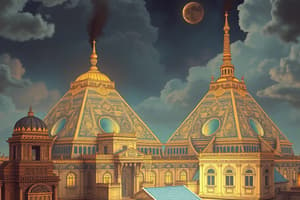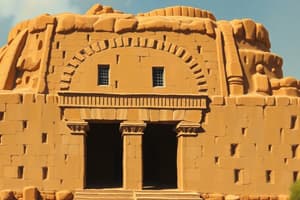Podcast
Questions and Answers
What construction technique involves the use of flat roofs supported by posts and lintels?
What construction technique involves the use of flat roofs supported by posts and lintels?
- Arcuated construction
- Trabeated construction (correct)
- Battered wall construction
- Cantilever construction
Which characteristic best describes the overall aesthetic of Egyptian architecture?
Which characteristic best describes the overall aesthetic of Egyptian architecture?
- Modernism
- Ornate intricacy
- Simplicity (correct)
- Fragility
What feature reflects the importance of hierarchy in the layout of buildings?
What feature reflects the importance of hierarchy in the layout of buildings?
- Scattered layout
- Random placement
- Axial planning (correct)
- Circular planning
What type of walls are characterized by a backward slope as they rise?
What type of walls are characterized by a backward slope as they rise?
Hieroglyphics served what dual purpose in Egyptian architecture?
Hieroglyphics served what dual purpose in Egyptian architecture?
What term describes the land associated with ancient Pharaohs?
What term describes the land associated with ancient Pharaohs?
What is a common characteristic of the materials used in Egyptian monumental buildings?
What is a common characteristic of the materials used in Egyptian monumental buildings?
Which of the following is NOT a typical feature of Egyptian architectural design?
Which of the following is NOT a typical feature of Egyptian architectural design?
What does the term 'Black Land' refer to in the context of Ancient Egypt?
What does the term 'Black Land' refer to in the context of Ancient Egypt?
Which of the following best describes the 'Red Land' in Ancient Egypt?
Which of the following best describes the 'Red Land' in Ancient Egypt?
What was the primary building material used in domestic structures in Ancient Egypt?
What was the primary building material used in domestic structures in Ancient Egypt?
What construction technique was primarily used in Ancient Egyptian architecture?
What construction technique was primarily used in Ancient Egyptian architecture?
What was the Ancient Egyptians' main concern reflected in their religious beliefs?
What was the Ancient Egyptians' main concern reflected in their religious beliefs?
Which material was primarily used for constructing temples in Ancient Egypt?
Which material was primarily used for constructing temples in Ancient Egypt?
Which of the following gods is NOT part of the Theban Triad?
Which of the following gods is NOT part of the Theban Triad?
What unique feature characterized the roofs of Ancient Egyptian buildings?
What unique feature characterized the roofs of Ancient Egyptian buildings?
What does the Eye of Horus symbolize?
What does the Eye of Horus symbolize?
Which symbol represents the kingship of Upper and Lower Egypt?
Which symbol represents the kingship of Upper and Lower Egypt?
The Scarab is primarily associated with which concept?
The Scarab is primarily associated with which concept?
What does the Feather of Ma'at represent?
What does the Feather of Ma'at represent?
Which of the following symbols is used to protect a royal name?
Which of the following symbols is used to protect a royal name?
The Ankh is often seen in the hands of which figures?
The Ankh is often seen in the hands of which figures?
What does the Crook and Flail symbolize in ancient Egypt?
What does the Crook and Flail symbolize in ancient Egypt?
Which symbol is associated with the concept of weighing the heart in the afterlife?
Which symbol is associated with the concept of weighing the heart in the afterlife?
What is the primary purpose of a mastaba in ancient Egyptian architecture?
What is the primary purpose of a mastaba in ancient Egyptian architecture?
Which of the following is NOT a characteristic of a mastaba?
Which of the following is NOT a characteristic of a mastaba?
What structural element seals the burial chamber in a mastaba?
What structural element seals the burial chamber in a mastaba?
Which pyramid is known as the oldest and largest in the Giza Complex?
Which pyramid is known as the oldest and largest in the Giza Complex?
Which of the following best describes the transition from mastabas to pyramids?
Which of the following best describes the transition from mastabas to pyramids?
Which pyramid is also referred to as the Red Pyramid?
Which pyramid is also referred to as the Red Pyramid?
What is a distinguishing feature of a step pyramid?
What is a distinguishing feature of a step pyramid?
Which ancient architect is credited with the design of the Step Pyramid of Djoser?
Which ancient architect is credited with the design of the Step Pyramid of Djoser?
What was the purpose of a mortuary temple in ancient Egyptian architecture?
What was the purpose of a mortuary temple in ancient Egyptian architecture?
Which pharaoh is associated with the Pyramid of Khafre?
Which pharaoh is associated with the Pyramid of Khafre?
What kind of burial information is provided within a mastaba?
What kind of burial information is provided within a mastaba?
Which of the following statements about mastabas is accurate?
Which of the following statements about mastabas is accurate?
Which of the following pyramids is the smallest and the last to be built in the Giza complex?
Which of the following pyramids is the smallest and the last to be built in the Giza complex?
Flashcards are hidden until you start studying
Study Notes
Architectural Character
- Egyptian architecture is characterized by simplicity, monumentality, and massiveness.
- Structures are designed with axial planning, emphasizing hierarchy through longitudinal arrangements.
- Trabeated construction employs post and lintel techniques with flat roofs composed of large stone blocks.
Construction Techniques
- Buildings use massive walls to support external structures and closely spaced columns.
- Battered walls feature a backward slope, enhancing stability.
- Hieroglyphics adorn both exterior and interior surfaces, providing insight into ancient Egyptian life, beliefs, and history.
Geographic Context
- The Nile River serves as the lifeblood of Egypt, fostering agriculture along its banks (Black Land).
- The Red Land refers to the surrounding barren desert, contrasting with the fertile areas.
- Climate is dry and hot, influencing architectural design with few windows and massive walls to accommodate hieroglyphic inscriptions.
Principles of Construction
- Predominantly post and lintel techniques are utilized, with flat roofs necessary due to minimal rainfall.
- Mud brick is the main material for domestic buildings, while temples primarily use stone.
Religious Beliefs
- Ancient Egyptians held a strong focus on eternity and the afterlife, reflected in the construction of pyramids.
- Multiple Egyptian gods, including Amun-Ra (chief god), Mut (queen of gods), and Khonsu (god of moon and time), played significant roles in daily life and rituals.
Royal Symbols
- Cartouches protect and signify royal names, while the Pschent symbolizes the unification of Upper and Lower Egypt.
- The Ankh represents life, and the Eye of Horus symbolizes protection and royal authority.
- Scarabs signify resurrection; the Feather of Ma’at embodies justice and balance in the afterlife.
Egyptian Structures
- Mastabas, originating from the Arabic word for "bench," serve as tombs for nobility, characterized by shaft access to underground chambers and rectangular structures made from mud.
- Pyramids evolved from mastabas, featuring rectangular bases and smooth, steep sides.
- The Step Pyramid of Djoser, designed by architect Imhotep, represents a significant architectural evolution.
Notable Pyramids
- The Great Pyramid of Giza, built for Pharaoh Khufu, is the oldest and largest of the Giza Complex, comparable in size to St. Peter’s Basilica in Rome.
- The North Pyramid (Red Pyramid) constructed by King Sneferu marks the transition to true pyramids.
- Other pyramids include the Pyramid of Khafre, flanked by the Sphinx, and the smaller Pyramid of Mykerinos.
Necropolis Components
- Mortuary temples function as places of worship for deceased rulers, reflecting the importance of religion in burial practices and daily rituals.
Studying That Suits You
Use AI to generate personalized quizzes and flashcards to suit your learning preferences.





